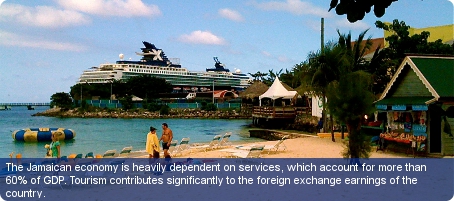Find a business in Jamaica

The island state of Jamaica in the Caribbean has a relatively large and diversified economy, but it is vulnerable to natural disasters and suffered in the latter part of the 2000s. It has a GNI per capita of US$5,120 (2012), but its GDP growth rate has been -1.1% per annum 2008-12. This is due to several hurricanes severely affecting economic output in the agricultural and tourism sectors. A very high public deficit has been maintained to rebuild the country’s infrastructure and economy after devastation but this has led to escalating inflation and falling living standards.
Jamaica has a more diverse range of minerals than many of the islands in the Caribbean. Limestone is Jamaica’s most abundant. The mining and processing of bauxite accounts for about 10% of the country’s GDP (2008), while the construction sector accounts for 10% of Jamaica’s GDP (2007). Most building construction projects are initiated by the government, though there are many incentives for private-sector clients.
In 2011, travel and tourism directly contributed 7.6% of GDP and generated 84,000 jobs – 7.2% of total employment (World Travel and Tourism estimate).
Despite having a relatively large and diverse economy Jamaica has been subjected to somewhat sluggish growth and high unemployment. In addition, the island was hit hard by Hurricane Ivan in late 2004 and has taken some time to recover from this. The economy is heavily dependent on services, which now account for 73% of GDP. Most of its foreign exchange comes from tourism, remittances and bauxite/alumina exports. Remittances account for nearly 15% of GDP and exports of bauxite and alumina make up about 10%. The bauxite/alumina sector was most affected by the global downturn in 2008-09 while the tourism industry was resilient, experiencing an increase of 4% in tourist arrivals.
The economy faces significant long-term problems: high but declining interest rates, increased foreign competition, exchange rate instability, a sizable merchandise trade deficit, large-scale unemployment and underemployment, and a high debt burden – the result of government bailouts to ailing sectors of the economy, most notably the financial sector in the mid-to-late 1990s.
By implementing a strong fiscal strategy from 2004, Jamaica has reduced its public debt to 133.3% of GDP. This achievement supports the substantial efforts have gone into bringing foreign investors to Jamaica by means of tax, customs and other incentives, developing its equity markets, and encouraging joint ventures and privatisation, notably of hotels.
Jamaica has almost 19,000 km of roads, about 70% of which are paved. The country’s main ports are in Kingston and Montego Bay in the north-west, with adequate facilities for bulk cargo. The country’s international airports are Norman Manley International, 17 km south-east of the capital Kingston, and Montego Bay International, 3km north of the capital.
Jamaica is ranked second best in the Latin America and Caribbean region for starting a business and third best for resolving insolvency, according to the World Bank’s ‘Doing Business 2012’ study. These rankings measure the conduciveness of a regulatory regime in starting and operating a business.
Jamaica has an 87.5% adult literacy rate (2012) and is an English-speaking nation. In 2006 around a fifth of the workforce were classified as senior managers, professionals or associate professionals.




